4.12. Another method for generating imputations is the sequential hot deck, where responding and nonresponding units are
Question:
4.12. Another method for generating imputations is the sequential hot deck, where responding and nonresponding units are treated in a sequence, and a missing value of Y is replaced by the nearest responding value preceding it in the sequence. For example, if n = 6, r = 3, y, y4, and ys are present and y2 y3, and y, are missing, then y and y, are replaced by y, and y, is replaced by ys. If y is missing, then some starting value is necessary, perhaps chosen from records in a prior survey. This method formed the basis for early imputation schemes for the Census Bureau's Current Population Survey. Suppose sampled units are regarded as randomly ordered, units are selected by simple random sampling, and a Bernoulli nonresponse mechanism is operating. Then show that the sequential hot-deck estimate of Y, say YHD3, is unbiased for with variance (for large r and n and ignoring finite population corrections) given by Var(HD3)= [1 + (n-r)/n]/r. Hence the proportionate increase in variance over yg is (nr)/n, the fraction of missing data. (See Bailar, Bailey and Corby, 1978, for details).
Step by Step Answer:

Statistical Analysis With Missing Data
ISBN: 9780471183860
2nd Edition
Authors: Roderick J. A. Little, Donald B. Rubin






